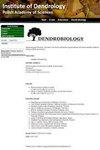Exogenous seed treatment with proline and its consequences to Norway spruce (Picea abies (L.) H. Karst) seedling establishment
IF 1.8
4区 农林科学
Q2 FORESTRY
引用次数: 0
Abstract
Accumulation of proline is a defense mechanism against external stress conditions, preventing damage to the structure and function of cells and improving plant development processes, such as germination. The purpose of this study was to investigate proline treatment as a means of improving the germination and development of Norway spruce seedlings. The effect of exogenous proline has been studied in three stages of initial plant development. The collected seeds were soaked in water or 8 mM proline solution and placed on the germinators. The germination capacity and the mean germination time were determined. Seedlings with radicles >10 mm were transferred to the sand-peat substrate at a constant temperature of 20 °C. Seedlings at 3 subsequent developmental stages (S1 – germinated seeds with radicles > 3 mm; S2 – seedlings with radicles >10 mm; S3 – established seedlings grown for 90 days) were examined for the oxygen consumption rate, total antioxidant capacity, hydrogen peroxide level, malondialdehyde level and intracellular proline content. Proline treatment was conducive to lowering the levels of hydrogen peroxide and malondialdehyde at stage S1. At the subsequent stages of development, the levels of hydrogen peroxide and malondialdehyde increased, and at the S3 stage, there was also a marked increase in total antioxidant capacity. At stage S3, the seedlings of the proline treatment were characterized by a lower total mass, and the response to exogenous proline was stronger in the root tissues than in the leaves. The oxygen consumption rate was higher for the proline treatment at all stages of development. Seedlings at the analyzed stages of establishment differed in response to proline treatment. Exogenous proline had some beneficial effects during the first phase of germination by reducing the level of hydrogen peroxide and improving the condition of lipid membranes. In the subsequent stages of seedling development, in response to the same concentration of proline solution, undesirable effects, such as an increase in hydrogen peroxide levels and damage to cytoplasmic membranes, were observed. Optimal concentrations of exogenous proline should be determined prior to commercial use of proline treatment to improve plant stress tolerance.脯氨酸外源种子处理对挪威云杉(Picea abies (L.))的影响H.喀斯特)育苗
脯氨酸的积累是抵御外部胁迫条件的防御机制,可以防止细胞结构和功能受损,并改善植物的发育过程,如发芽。本研究的目的是研究脯氨酸处理作为改善挪威云杉幼苗发芽和发育的一种手段。研究了外源脯氨酸在植物发育初期的三个阶段的作用。将收集的种子浸泡在水或8mM脯氨酸溶液中,并放置在生发器上。测定了发芽率和平均发芽时间。将胚根>10mm的幼苗在20°C的恒温下转移到沙泥炭基质上。对随后3个发育阶段的幼苗(S1–胚根>3 mm的发芽种子;S2–胚根>10 mm的幼苗;S3–培养90天的幼苗)的耗氧率、总抗氧化能力、过氧化氢水平、丙二醛水平和细胞内脯氨酸含量进行了检测。脯氨酸处理有利于降低S1阶段的过氧化氢和丙二醛水平。在随后的发育阶段,过氧化氢和丙二醛的水平增加,在S3阶段,总抗氧化能力也显著增加。在S3阶段,脯氨酸处理的幼苗的特征是总质量较低,并且根组织对外源脯氨酸的反应比叶片更强。脯氨酸处理在发育的各个阶段的耗氧率都较高。所分析的建立阶段的幼苗对脯氨酸处理的反应不同。外源脯氨酸在发芽的第一阶段通过降低过氧化氢水平和改善脂质膜的条件而发挥了一些有益的作用。在幼苗发育的随后阶段,对相同浓度的脯氨酸溶液的反应,观察到了不良影响,如过氧化氢水平的增加和对细胞质膜的损伤。在商业使用脯氨酸处理以提高植物抗逆性之前,应确定外源脯氨酸的最佳浓度。
本文章由计算机程序翻译,如有差异,请以英文原文为准。
求助全文
约1分钟内获得全文
求助全文
来源期刊

Dendrobiology
农林科学-林学
CiteScore
2.20
自引率
11.10%
发文量
17
审稿时长
>12 weeks
期刊介绍:
Dendrobiology publishes original research articles and review articles related to the biology of trees and shrubs.
 求助内容:
求助内容: 应助结果提醒方式:
应助结果提醒方式:


